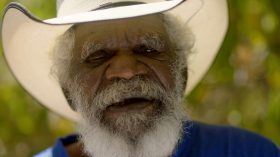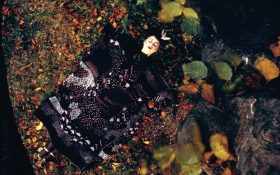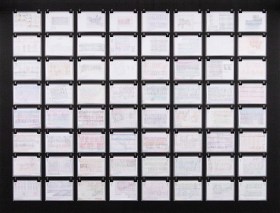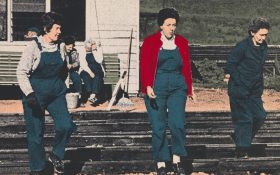Careful rows of empty toothpaste tubes. Neatly folded triangles of different colours which reveal themselves to be plastic bags on closer inspection. A wonderfully colourful sea of 10,000 objects all carefully organised and laid out, together forming an archive of sorts, and filling the expansive foyer of Carriageworks. One particularly bright area of Song Dong’s Waste Not catches my eye: these different coloured circles turn out to be soft drink lids; they have never looked so pretty and appealing. A friend I am with who lived in Malaysia as a child mentions that she finds the work very nostalgic when she notices a plastic basin – the same as one she was bathed in as a child.
Song Dong’s work Waste Not is intensely personal, conceived by the artist following his father’s death. The work was intended as a means through which Dong’s mother, Zhao Xiangyuan, could grieve, but also create something with her son that could bring her out of the depression she was suffering. A striking feature of this work is how it seems to sit in virtual opposition to the disposable, plastic-fantastic China of today. Waste Not is a meditation on life during the Cultural Revolution when times were hard and possessions were cherished. The Communist era saying ‘wu jin qu yong’, translates as ‘waste not’ and was a way of survival during those difficult times. Dong’s mother could not give away this life of thrift even after the Cultural Revolution ended, saving everything; not just things that could possibly be re-used, but even objects which most would consider junk.
It is hard to pinpoint what it is about Waste Not that appeals – these household items undergo a transformation, they become beautiful when organised and neatly grouped with such care in this context. Leaving their functionality behind these objects signify not only of the culmination of one person’s life through their possessions, but China at a certain point in time, a China of the past.
Dong was born in Beijing in 1966. His practice spans sculpture, installation and performance art, exploring themes such as his relationship with his family, central to Waste Not. In other works Dong examines Beijing itself and the impact that recent development is having on the city, and the dramatic economic and social changes occurring in China.
Coinciding with Waste Not is another exhibition, Mum and Dad, Don’t Worry About Us, We Are All Well at Chinatown’s 4A Centre for Contemporary Asian Art. The exhibition is spread over two floors and includes more than half a dozen works; a thick set of roomsheets provide detailed background and context for Dong’s candid works.
A very personal background is given for the work, Touching My Father. Dong explains how his father was sent to a re-education camp during the Cultural Revolution. The artist remembers visiting his father there, recalling his love and admiration for him and his father’s sharp, spiky beard. As Dong grew up, communications between father and son became strained. In Touching My Father, Dong creates a projection of an immaterial, virtual hand that is able to touch his father as it is projected onto a video of him. Through the action of creating this work, Dong and his father’s relationship was strengthened and deep generational gaps were bridged. A new intimacy emerged between the two.
In Cut One Fen into Two Parts With My Mother, an old family photo from 1983 shows a young Song Dong trying to share half a banana with his mother, just years after the end of the Cultural Revolution. The family were still poor and Dong’s mother would insist upon saving all the good food for her children and never indulging herself. Accompanying the photograph is a fen (the smallest denomination of RMB currency) cut into two parts; it forms a literal incarnation of the Cultural Revolution-era adage of ‘cutting one fen into two’, a rule of thumb for living frugally during hard times, and a reminder to not waste anything during easier times.
Father and Son with my Daughter builds on an earlier work titled Images of Father and Son Together. In Father and Son with my Daughter, Dong’s daughter moves between the images of Dong and his father from the earlier work; her face touches and meets their faces creating, in Dong’s words, ‘a new person’. As this ‘new person’ is created, family facial similarities become apparent as different generations of Dong’s family have the opportunity to meet through his artwork. Dong explains how it was his father’s, and also his daughter’s, greatest regret that they never got to meet one another.
Dong’s work is extremely candid and intensely personal. For me it provides a greater understanding of a period in Chinese history that was so hidden from the rest of the world. Through a personal account of this time the lasting impact of the Cultural Revolution on one family becomes apparent.
Dong’s work explores the importance of the family unit and parent-child relationships. Through his video works, for example Father and Son with my Daughter, Dong is able to create virtual spaces where the artist spans time to allow connections to be established between different generations of his family; it is also in this virtual, created realm that Dong and his father are able to reconcile and strengthen their relationship.
Rating: 4 stars out of 5
Song Dong: Waste Not
Carriageworks, Eveleigh
5 January – 17 March
Song Dong: Dad and Mum, Don’t Worry About Us, We Are All Well
4A Centre for Contemporary Asian Art, Haymarket
5 January – 30 March
Sydney Festival 2013
www.sydneyfestival.org.au
5 – 27 January





